CAMS: Suicide Prevention Evidence-Based Practice
The CAMS suicide prevention assessment, intervention & treatment Is backed by 30 years of ongoing clinical research
Replicated data across various clinical research studies show the CAMS approach to suicidal risk:
- Quickly reduces suicidal ideation in 6-8 sessions;
- Reduces overall symptom distress, depression, changes suicidal cognitions, and decreases hopelessness;
- Increases hope and improves clinical retention to care;
- Is liked by patients who use it;
- May be optimal for suicidal ideation;
- Best proven treatment as demonstrated by randomised trials
- Decreases Emergency Department (ED) visits among certain subgroups;
- Appears to have a promising impact on \behaviour and suicide attempts;
- Is relatively easy to learn, and become concordant.
CAMS Meta-Analysis: Intervention for Suicidal Ideation
Meta-analysis concludes that CAMS is “well supported” as a clinical intervention for suicidal ideation per guideline standard criteria
RESEARCH
A brand new meta-analysis of nine clinical trials showing robust support for the Collaborative Assessment and Management of Suicidality (CAMS) has just been published in the suicide prevention field’s premier peer-reviewed scientific journal, Suicide and Life-Threatening Behavior. The CAMS meta-analysis project was led by Dr Joshua Swift, a well-established psychotherapy treatment researcher, who is an associate professor of clinical psychology at Idaho State University (ISU). Dr. Swift along with two graduate students pursued a rigorous meta-analysis of CAMS clinical trials during the summer of 2020, submitting their manuscript for peer-review in the fall. This meta-analysis was sponsored by CAMS-care with the goal of supporting an independent research laboratory to conduct a demanding and labour-intensive meta-analysis (which is a large study of various studies that meet certain key selection criteria). It is noteworthy that Swift and his team are not suicide treatment researchers which helped ensure a fresh and unbiased perspective to this rigorous scholarly undertaking. To conduct this meta-analysis, the ISU research team identified over 1000 published and unpublished articles, theses, and dissertations that referred to ‘CAMS’ or ‘SSF’ (the Suicide Status Form is a multipurpose assessment and treatment tool used within CAMS). Using certain selection criteria (e.g. empirical clinical trial data vs conceptual; having a comparison control group design vs no control comparison) the team eventually identified and selected 9 clinical trials of CAMS comparing it to control treatments, such as ‘treatment as usual’ (TAU) and one Danish trial comparing CAMS to Dialectical Behavior Therapy (DBT for self harm). Once the selected studies were identified, the team performed a series of statistical analyses across the studies so as to investigate the relative effect sizes related to clinical treatment outcomes (i.e., a measure of the relative impact of the interventions on certain key outcome variables). In other words, the overall impact of study treatments within and across all the selected clinical trials can all be compared within a meta-analysis (and additional analyses related to ‘moderator effects’ were also studied). The results of their efforts were impressive. The research team found that in comparison to control treatments, CAMS caused significant reductions in suicidal ideation and overall symptom distress while positively impacting hope/hopelessness and increasing treatment acceptability. There was non-significant—but trending—support for its positive impact on suicidal attempts, self-harm, and cost-effectiveness (but more data are needed to see if these effects could reach statistical significance). Importantly, in none of the 9 selected clinical trials of CAMS was comparison treatment ever better than CAMS when overall “weighted averages” across studies for each clinical outcome were calculated. There were no significant differences between the use of CAMS with white vs. non-white patients (but more diverse clinical samples are clearly needed; the European CAMS studies to date have primarily had patients who were Caucasian). Dr. Swift’s team ultimately concluded that CAMS is “well supported” as a clinical intervention for suicidal ideation as per Centre for Disease Control criteria (which is the highest level of empirical support). Access the original article by Dr. Swift: The effectiveness of the Collaborative Assessment and Management of Suicidality (CAMS) compared to alternative treatment conditions: A meta-analysis So, what does all this rigorous research of various clinical trials actually mean? In short, this meta-analysis of CAMS is a breakthrough investigation that caps off almost 30 years of hard-earned clinical trial research which first focused on the early use of the SSF that later evolved into the suicide-focused clinical intervention that CAMS has become. This meta-analysis convincingly confirms that using this suicide-focused therapeutic framework works for many patients who are suicidal around the world and in different treatment settings (e.g., outpatient settings, crisis clinics, and inpatient settings). It confirms that emphasising the four “pillars” of CAMS—collaboration, empathy, honesty, and being suicide-focused—is indeed a proven way of reliably decreasing suicidal ideation and reducing serious psychiatric distress. One notable finding from the meta-analysis is that the most robust weighted average was for the outcome of decreasing patients’ hopelessness while increasing their hope. This is an important finding and a convincing testament to the effectiveness of CAMS for patients who are suicidal around the world across a range of clinical settings. We can now say with confidence that CAMS effectively treats the largest challenge that we face in the field of suicide prevention today: the massive population of people who struggle with serious thoughts of suicide.
RELEVANT CITATION
- Swift JK, Trusty WT, Penix EA. The effectiveness of the Collaborative Assessment and Management of Suicidality (CAMS) compared to alternative treatment conditions: A meta-analysis. Suicide Life Threat Behav. 2021;00:1–15. Access the article.
Explore the various research studies to learn how CAMS is being utilized effectively
RANDOMISED CONTROLLED TRIALS (RCT’s)
Gold standard of proven treatment
RESEARCH
- CAMS-Next Day Appointment (NDA) Study: The CAMS-NDA RCT was funded by the American Foundation for Suicide Prevention (AFSP). This was a small feasibility-oriented RCT comparing CAMS to Enhanced Care as Usual (E-CAU) with a community-based sample of suicidal outpatients. In this study, 32 suicidal outpatients were randomly assigned to the respective treatment arms in an outpatient mental health treatment clinic housed within a large urban medical centre. Despite limited statistical power given the small sample, there were statistically significant experimental findings on all our primary and secondary measures including between-group differences in suicidal ideation, overall symptom distress, and optimism/hope. Importantly, the experimental between-group differences were most robust at the most distal assessment time point (12 months after the index treatment assessment) showing the possible enduring causal impact of CAMS long after the treatment ended (on average around eight sessions). Finally, CAMS patient satisfaction ratings were significantly higher than control patient ratings and the patients receiving CAMS care demonstrated superior treatment retention in comparison to control patients. Access a copy of the journal article: Comtois, Jobes, O’Connor et al 2011
- DBT for self harm vs. CAMS RCT (the DIAS RCT): Researchers in Copenhagen Denmark conducted a well-powered RCT using a parallel group superiority design in which 108 suicide attempters with Borderline Personality Disorder traits were randomly assigned to either Dialectical Behavior Therapy (DBT for self harm) or “CAMS-Informed Supportive Psychotherapy.” Data from this study showed no significant differences between DBT for self harm and CAMS for the treatment of self-harm and suicide attempts. As DBT for self harm is a proven and highly effective treatment for self-harm and suicide attempts this finding was encouraging particularly because patients received significantly less clinical contact (1X/week of CAMS for an average of 10 sessions vs. 2Xweek of DBT for self harm for 16 weeks). Access a copy of the journal article: Andreasson, Krogh, Wenneberg et al 2016
- Operation Worth Living (OWL) Study: The “Operation Worth Living” (OWL) study funded by the US Department of Defence was a well-powered RCT of CAMS vs. Enhanced Care as Usual with an “intent-to-treat” sample of 148 suicidal U.S. Army Soldiers at an outpatient military treatment facility. In this study, CAMS significantly eliminated suicidal ideation in 6-8 sessions significantly more quickly than control care at 3 months follow up and this reduction in ideation was maintained at 6 and 12 months. There are “moderator” data showing that CAMS was significantly better than control care for 6 of 8 significant findings showing that subgroups of CAMS patients had decreased visits to the emergency department, decreases in overall symptom distress, and increases in resilience. Access a copy of the journal articles: Jobes, Comtois, Gutierrez, Brenner et al 2017, Huh, Jobes, Comtois, et al 2018
- Managing suicidality within specialized care: A randomised controlled trial Researchers in Oslo Norway, conducted a rigorous RCT comparing CAMS to TAU for 80 suicidal patients across 4 different treatment settings. After 6 months, the results demonstrated a significant impact for CAMS on suicidal ideation and overall symptom distress compared to TAU. Access a copy of the journal article: Ryberg et al 2019.
- A Randomized Controlled Trial of the Collaborative Assessment and Management of Suicidality (CAMS) Versus Treatment as Usual (TAU) for Suicidal College Students This study (comparing CAMS and TAU in college counselling centres) has shown that an evidence-based, suicide-specific treatment like CAMS can be used within routine college counselling centres practice with positive findings. The findings in this study suggest that a suicide-specific approach such as CAMS is, on average, more likely to impact suicidal ideation and depression in suicidal college students, even over a relatively brief course of treatment. The researchers infer “that the suicide-specific focus of CAMS may be particularly beneficial for college students who are experiencing (1) a first suicidal crisis, or (2) acute (versus chronic) suicidal ideation, and/or (3) fewer BPD symptoms. Perhaps the ability to speak freely about suicidal ideation and plans, as well as identify and target client-defined suicidal drivers in CAMS helps normalise these feelings and enables clients to find alternatives to suicidal coping.” The study also finds that “students with BPD features and history of multiple attempts are likely optimal candidates for an intensive treatment such as DBT for self harm (which we have previously proposed in developing adaptive strategies for treatment non-responders to first-stage approaches—Pistorello et al., 2018). While there is some evidence that CAMS may be able to “compete” with DBT for self harm using fewer sessions and resources (Andreasson et al., 2016), the overwhelming evidence base would underscore the therapeutic superiority of DBT for self harm with more chronic, dysregulated, multiple attempting individuals (e.g., DeCou, Comtois, & Landes, 2019; Kliem, Kroger, & € Kosfelder, 2010; Linehan 1993).” Access a copy of the journal article: Pistorello et al 2020.
Additional supportive RCT data from unpublished RCT’s in the US and abroad
Four ongoing RCT’s (Aftercare Focus Study (AFS), Rapid Referral to Suicide Specific Intervention in Psychiatric Emergency Care, Virtual CAMS for Suicidal Patients in the Emergency Department and Suicidal Inpatients (Santel et al)) are presently being conducted in Seattle, Washington, San Diego, and Germany with other RCT’s in the planning stages. Several RCTs of CAMS with children and teenagers are currently being developed for funding.
RELEVANT CITATIONS
| Principal Investigator | Setting & Population | Design & Method | Sample Size | Status Update |
|---|---|---|---|---|
| Comtois (Jobes) | Harborview/Seattle CMH Patients | CAMS vs.VTAU Next Day Appts. | 32 |  2011 published article 2011 published article |
| Andreasson (Nordentoft) | Danish Centers CMH patients | DBT for self harm vs. CAMS superiority trial | 108 |  2016 published article 2016 published article |
| Jobes (Comtois et al) | Ft. Stewart, GA US Army Soldiers | CAMS vs. E-CAU | 148 |  2017 published article 2017 published article |
| Ryberg (Fosse) | Norwegian Centres Outpatient/inpatient | CAMS vs. TAU | 78 |  2019 published article 2019 published article |
| Pistorello (Jobes) | Univ. Nevada (Reno) College Students | SMART Design CAMS/TAU/DBT for self harm | 62 |  2020 published article 2020 published article |
| Comtois (Jobes) | Harborview/Seattle Suicide attempters | CAMS vs. TAU Post-Hospital D/C | 150 | ITT Complete; ongoing assess |
| Santel et al | German Crisis Unit Inpatients | CAMS vs. TAU | 110 | ITT Complete; ongoing assess |
| Depp et al | San Diego VAMC Walk In Veterans | CAMS vs. Outreach Same Day Services | 176 | RTC preparation ongoing |
RELEVANT CITATIONS
- Comtois, K. A., Jobes, D. A., O’Connor, S., Atkins, D. C., Janis, K., Chessen, C., Landes, S. J., Holen, A., & Yuodelis Flores, C. (2011). Collaborative assessment and management of suicidality (CAMS): Feasibility trial for next-day appointment services. Depression and Anxiety, 28, 963-972. Access the DOI.
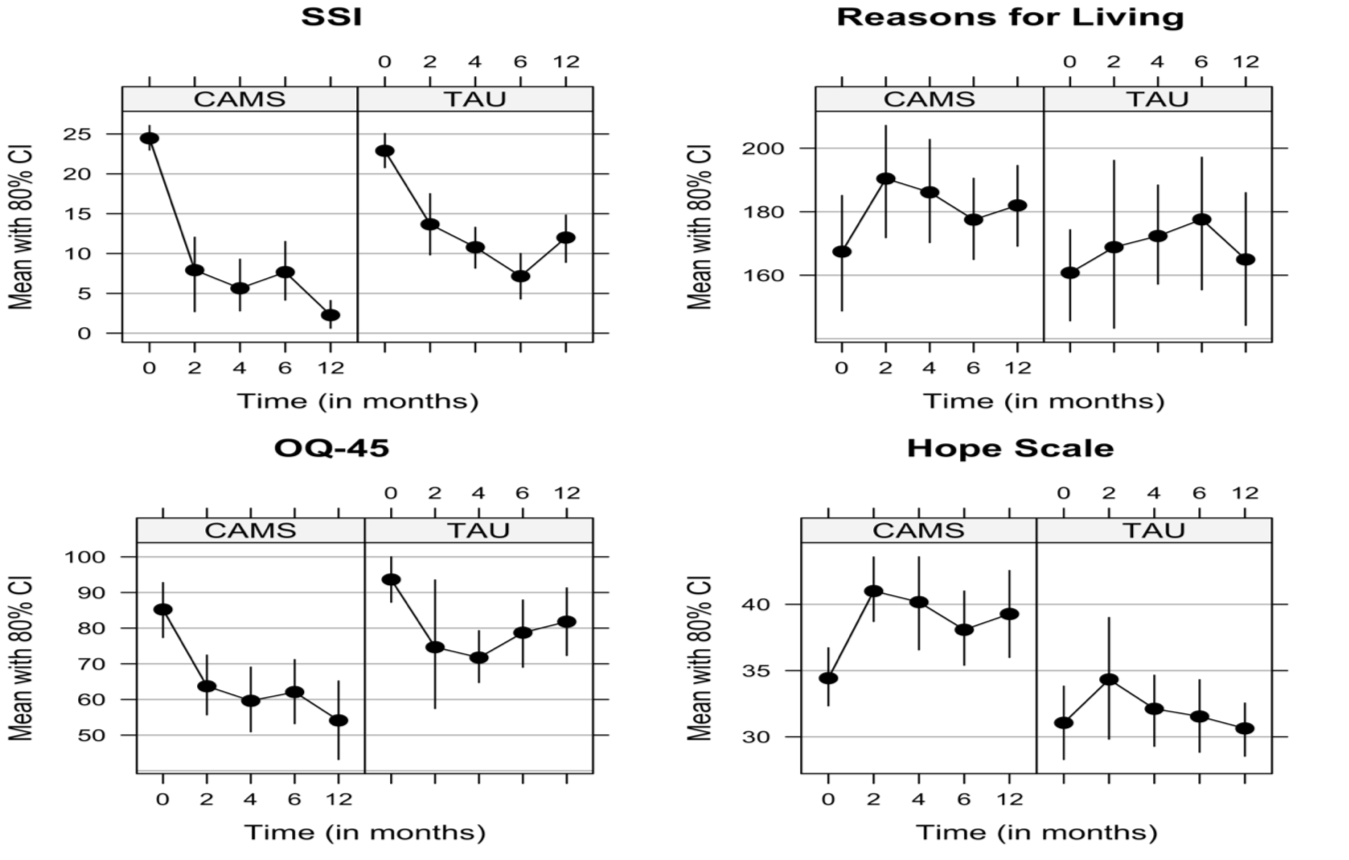
AFSP-Funded CAMS vs.TAU RCT (Comtois & Jobes et al., 2011). Significantly higher patient satisfaction ratings and better clinical retention…
- Andreasson, K, Krogh, J., Wenneberg, C., Jessen, H. L. K., Krakauer, K., Gluud, C., Thomsen, R. R., Randers, L., & Nordentoft, M. (2016). Effectiveness of Dialectical Behaviour Therapy Versus Collaborative Assessment and Management of Suicidality Treatment for Reduction of Self-Harm in Adults with Borderline Personality Traits and Disorder–A Randomised Observer-Blinded Clinical Trial. Depression and Anxiety. Access the DOI.
- Wenche, R., Fosse, R., Zahl, P. H., Brorson, I. W., Moller, P., Landro, N. I., & Jobes, D. (2016). Collaborative assessment and management of suicidality (CAMS) compared to treatment as usual (TAU) for suicidal patients: Study protocol for a randomised controlled trial. Trials Journal. Access the DOI.
- Jobes, D. A., Comtois, K.A., Gutierrez, P. M., Brenner, L. A., Huh, D., Chalker, S. A., Ruhe, G., Kerbrat, A. H., Atkins, D. C., Jennings, K., Crumlish, J., Corona, C. D., O’Connor, S., Hendricks, K. E., Schembari, B., Singer, B., & Crow, B. (2017). A randomised controlled trial of the collaborative assessment and management of suicidality versus enhanced care as usual with suicidal soldiers. Psychiatry: Interpersonal and Biological Processes, 80, 339–356. Access the DOI.
- David Huh, David A. Jobes, Katherine Anne Comtois, Amanda H. Kerbrat, Samantha A. Chalker, Peter M. Gutierrez & Keith W. Jennings (2018) The collaborative assessment and management of suicidality (CAMS) versus enhanced care as usual (E-CAU) with suicidal soldiers: Moderator analyses from a randomised controlled trial, Military Psychology, 30:6, 495-506. Access a copy of the article.
- Pistorello, J., Jobes, D. A., Compton, S., Locey, N. S., Walloch, J. C., Gallop, R., Au, J., Noose, S. K., Young, M., Johnson, J., Dicken, Y., Chatham, P., Jeffcoat, T., Dalto, G., & Goswami, S. (2017). Developing adaptive treatment strategies to address suicidal risk in college students: A pilot Sequential Multiple Assignment Randomized Trial (SMART). Archives of Suicide Research. Access the article.
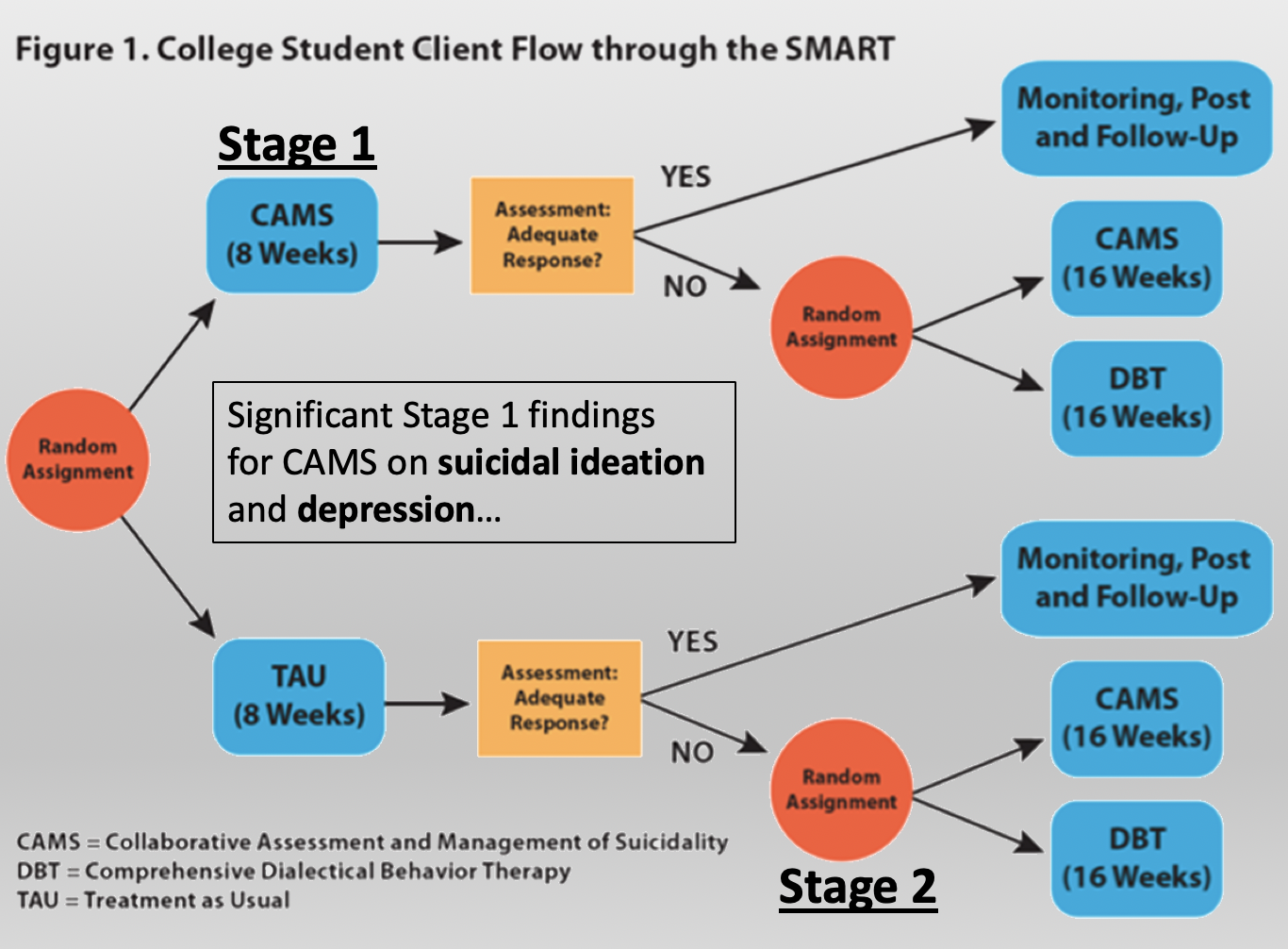
NIMH-Funded R-34; Pl: Jacque Pistorello, Ph.D.; Co-I: David Jobes, Ph.D. (n=62). Figure 1. College Student Client Flow through the SMART. Significant Stage 1 findings for CAMS on suicidal ideation and depression.
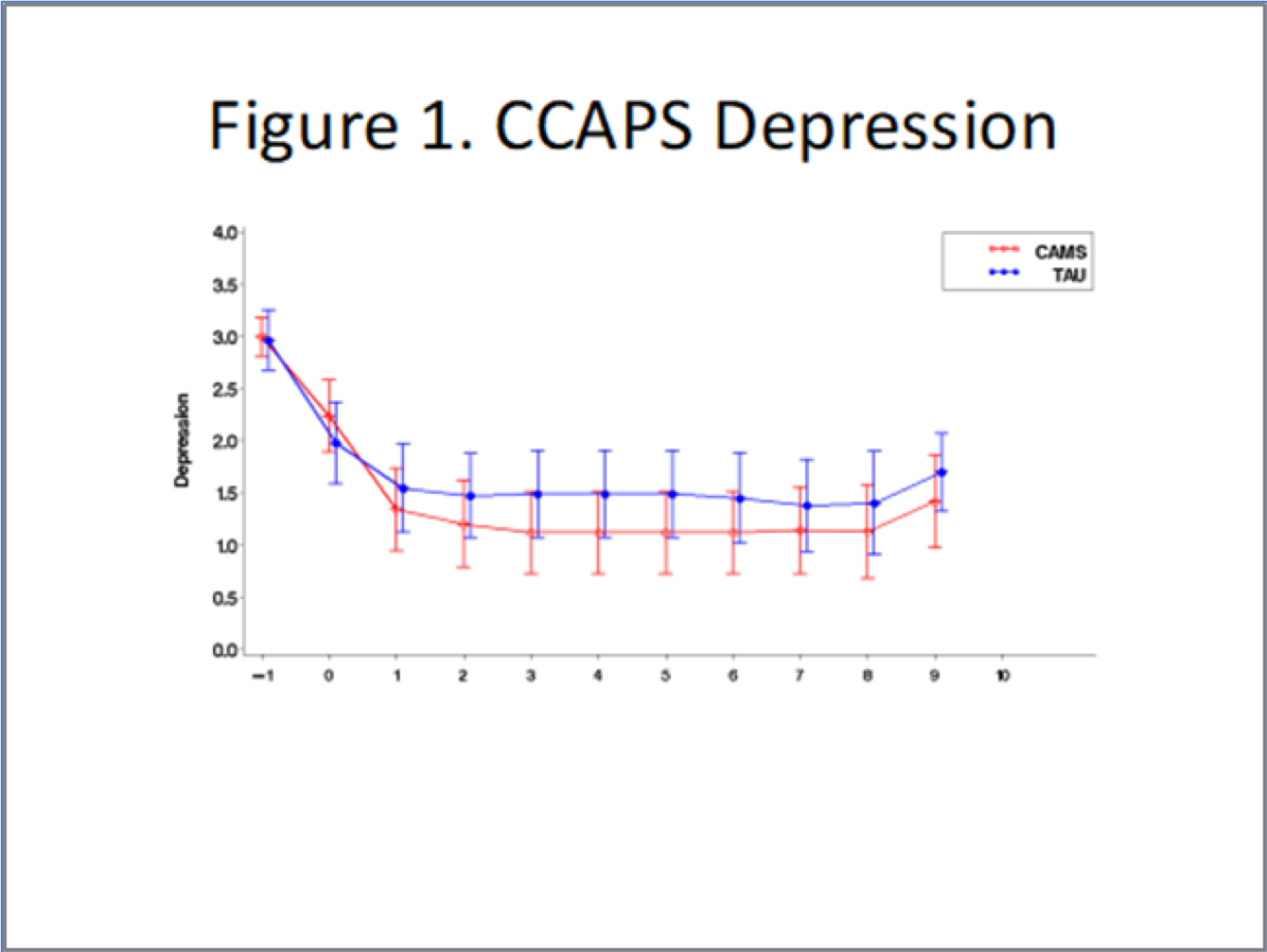
NIMH-Funded R-34; Pl: Jacque Pistorello, Ph.D.; Co-I: David Jobes, Ph.D. (n=62). Figure 1. CCAPS Depression.
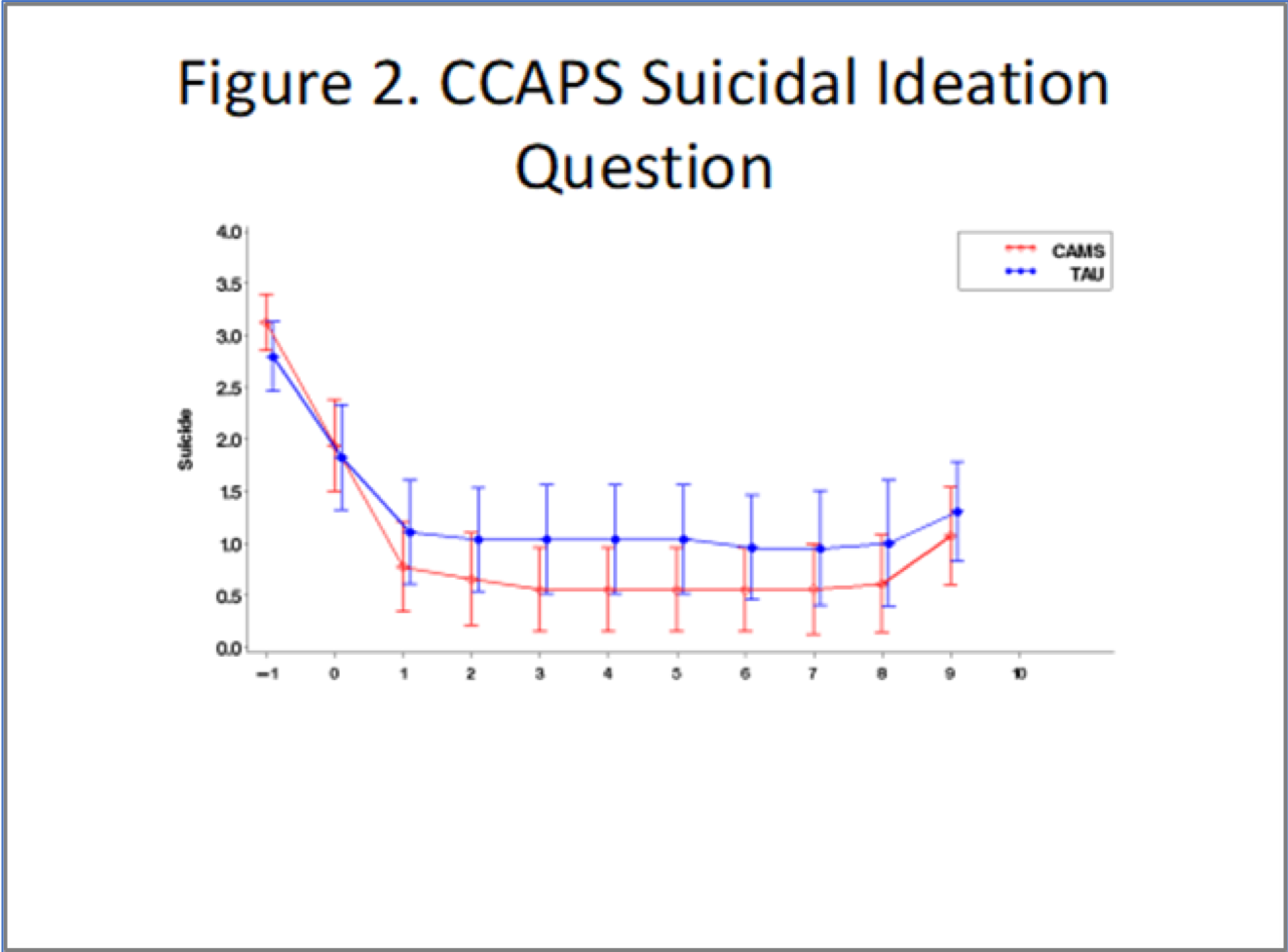
NIMH-Funded R-34; Pl: Jacque Pistorello, Ph.D.; Co-I: David Jobes, Ph.D. (n=62). Figure 2. CCAPS Suicidal Ideation Question.
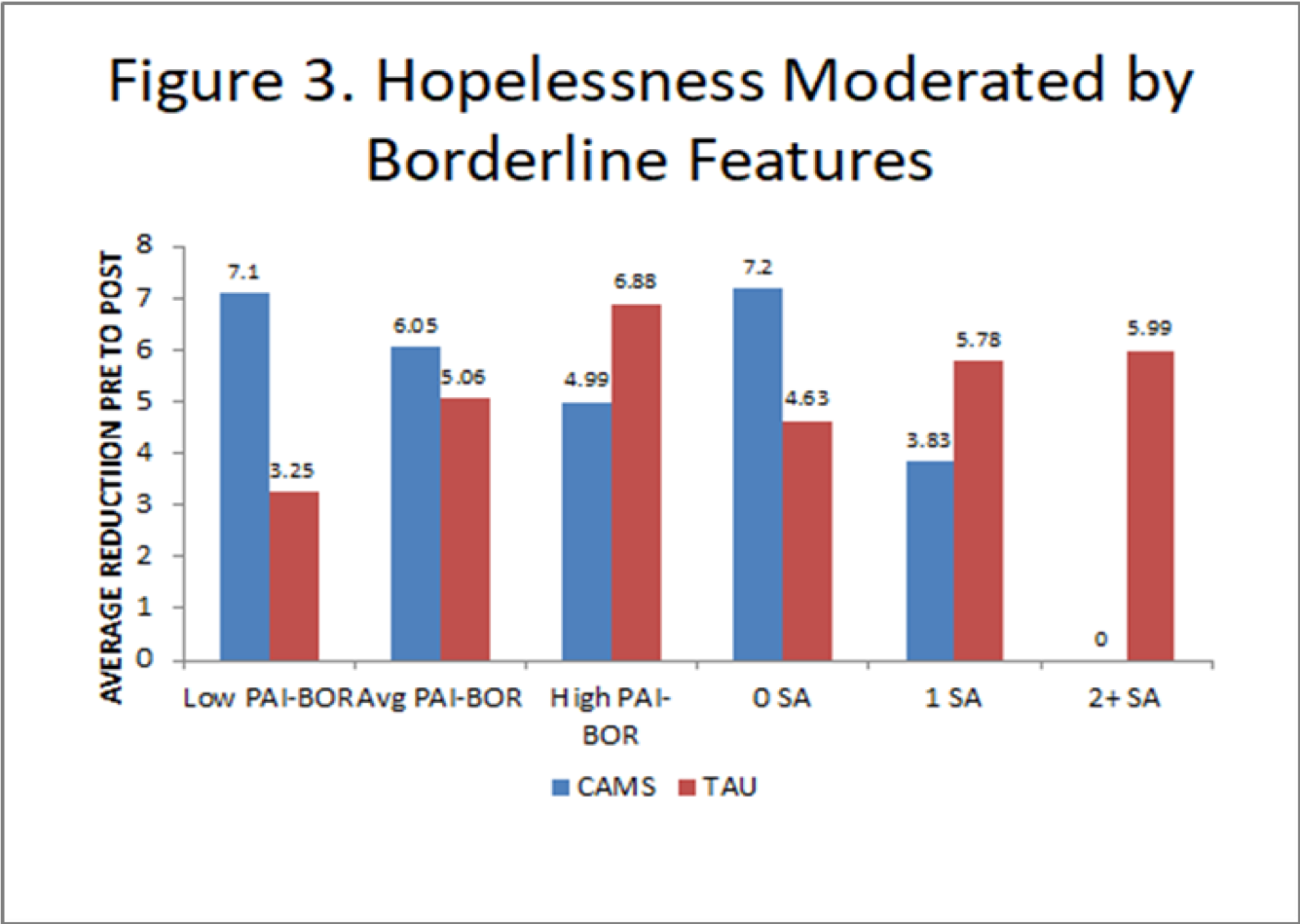
NIMH-Funded R-34; Pl: Jacque Pistorello, Ph.D.; Co-I: David Jobes, Ph.D. (n=62). Figure 3. Hopelessness Moderated by Borderline Features.
- Dimeff et al., (2018). DA novel engagement of suicidality in the emergency department: Virtual Collaborative Assessment and Management of Suicidality. Access a copy of the article.

Fig. 1. “Dr. Dave” avatar—graphic representation of scale anchors.

Fig. 2. Peer specialist video.
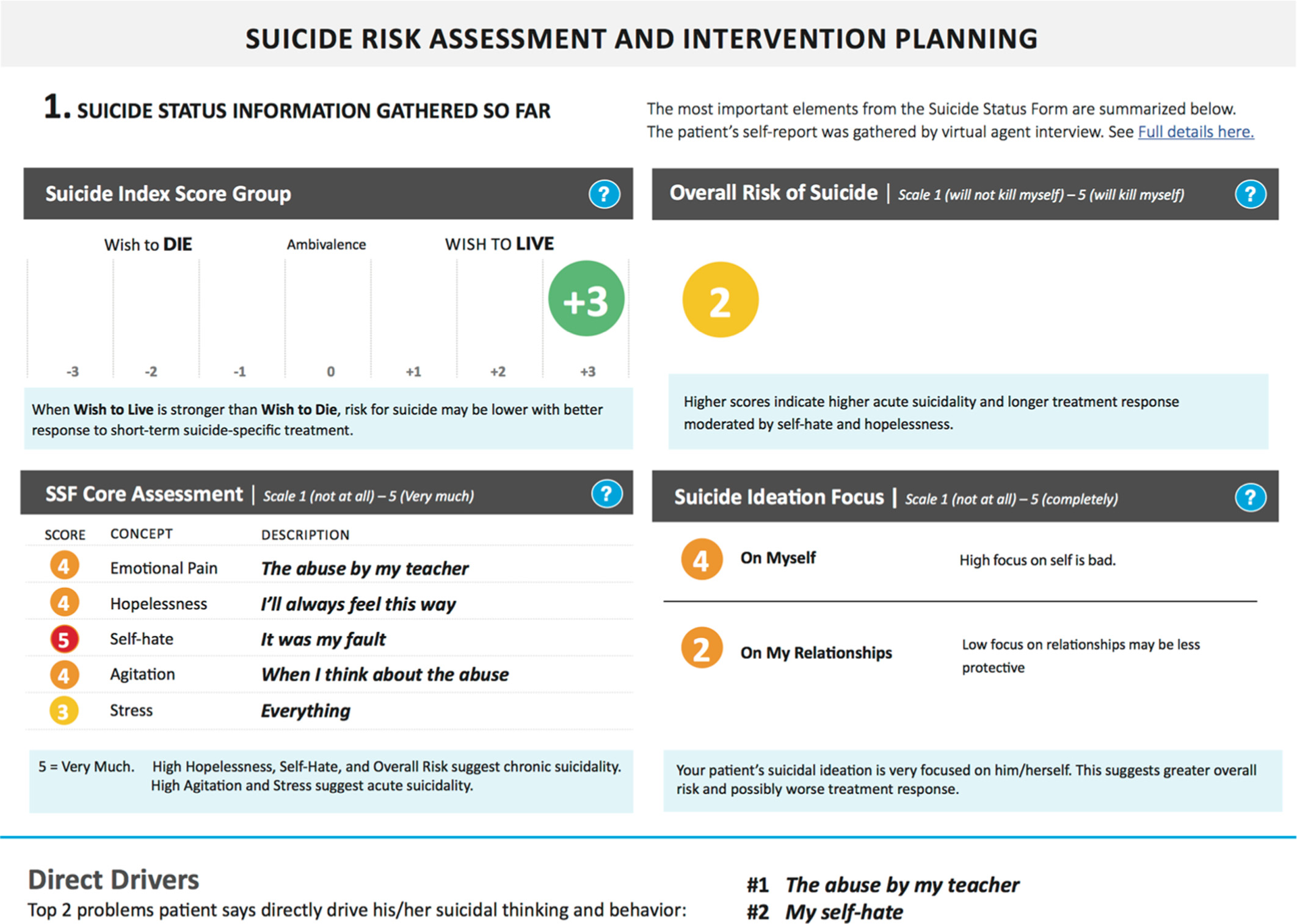
FFig. 3. V-CAMS SSI template.
RESEARCH
- CAMS-Next Day Appointment (NDA) Study: The CAMS-NDA RCT was funded by the American Foundation for Suicide Prevention (AFSP). This was a small feasibility-oriented RCT comparing CAMS to Enhanced Care as Usual (E-CAU) with a community-based sample of suicidal outpatients. In this study, 32 suicidal outpatients were randomly assigned to the respective treatment arms in an outpatient mental health treatment clinic housed within a large urban medical center. Despite limited statistical power given the small sample, there were statistically significant experimental findings on all our primary and secondary measures including between-group differences in suicidal ideation, overall symptom distress, and optimism/hope. Importantly, the experimental between-group differences were most robust at the most distal assessment time point (12 months after the index treatment assessment) showing the possible enduring causal impact of CAMS long after the treatment ended (on average around eight sessions). Finally, CAMS patient satisfaction ratings were significantly higher than control patient ratings and the patients receiving CAMS care demonstrated superior treatment retention in comparison to control patients. Access a copy of the journal article: Comtois, Jobes, O’Connor et al 2011
- DBT for self harm vs. CAMS RCT (the DIAS RCT): Researchers in Copenhagen Denmark conducted a well-powered RCT using a parallel group superiority design in which 108 suicide attempters with Borderline Personality Disorder traits were randomly assigned to either Dialectical Behavior Therapy (DBT for self harm) or “CAMS-Informed Supportive Psychotherapy.” Data from this study showed no significant differences between DBT for self harm and CAMS for the treatment of self-harm and suicide attempts. As DBT for self harm is a proven and highly effective treatment for self-harm and suicide attempts this finding was encouraging particularly because patients received significantly less clinical contact (1X/week of CAMS for an average of 10 sessions vs. 2Xweek of DBT for self harm for 16 weeks). Access a copy of the journal article: Andreasson, Krogh, Wenneberg et al 2016
- Operation Worth Living (OWL) Study: The “Operation Worth Living” (OWL) study funded by the US Department of Defense was a well-powered RCT of CAMS vs. Enhanced Care as Usual with an “intent-to-treat” sample of 148 suicidal U.S. Army Soldiers at an outpatient military treatment facility. In this study, CAMS significantly eliminated suicidal ideation in 6-8 sessions significantly more quickly than control care at 3 months follow up and this reduction in ideation was maintained at 6 and 12 months. There are “moderator” data showing that CAMS was significantly better than control care for 6 of 8 significant findings showing that subgroups of CAMS patients had decreased visits to the emergency department, decreases in overall symptom distress, and increases in resilience. Access a copy of the journal articles: Jobes, Comtois, Gutierrez, Brenner et al 2017, Huh, Jobes, Comtois, et al 2018
- Managing suicidality within specialized care: A randomized controlled trial Researchers in Oslo Norway, conducted a rigorous RCT comparing CAMS to TAU for 80 suicidal patients across 4 different treatment settings. After 6 months, the results demonstrated a significant impact for CAMS on suicidal ideation and overall symptom distress compared to TAU. Access a copy of the journal article: Ryberg et al 2019.
- A Randomized Controlled Trial of the Collaborative Assessment and Management of Suicidality (CAMS) Versus Treatment as Usual (TAU) for Suicidal College Students This study (comparing CAMS and TAU in college counseling centers) has shown that an evidence-based, suicide-specific treatment like CAMS can be used within routine college counseling centers practice with positive findings. The findings in this study suggest that a suicide-specific approach such as CAMS is, on average, more likely to impact suicidal ideation and depression in suicidal college students, even over a relatively brief course of treatment. The researchers infer “that the suicide-specific focus of CAMS may be particularly beneficial for college students who are experiencing (1) a first suicidal crisis, or (2) acute (versus chronic) suicidal ideation, and/or (3) fewer BPD symptoms. Perhaps the ability to speak freely about suicidal ideation and plans, as well as identify and target client-defined suicidal drivers in CAMS helps normalize these feelings and enables clients to find alternatives to suicidal coping.” The study also finds that “Students with BPD features and history of multiple attempts are likely optimal candidates for an intensive treatment such as DBT for self harm (which we have previously proposed in developing adaptive strategies for treatment non-responders to first-stage approaches—Pistorello et al., 2018). While there is some evidence that CAMS may be able to “compete” with DBT for self harm using fewer sessions and resources (Andreasson et al., 2016), the overwhelming evidence base would underscore the therapeutic superiority of DBT for self harm with more chronic, dysregulated, multiple attempting individuals (e.g., DeCou, Comtois, & Landes, 2019; Kliem, Kroger, & € Kosfelder, 2010; Linehan 1993).” Access a copy of the journal article: Pistorello et al 2020.
Additional supportive RCT data from unpublished RCT’s in the US and abroad
Four on-going RCT’s (Aftercare Focus Study (AFS), Rapid Referral to Suicide Specific Intervention in Psychiatric Emergency Care, Virtual CAMS for Suicidal Patients in the Emergency Department and Suicidal Inpatients (Santel et al)) are presently being conducted in Seattle, Washington, San Diego, and Germany with other RCT’s in the planning stages. Several RCT’s of CAMS with children and teenagers are currently being developed for funding.
RELEVANT CITATIONS
Randomized Controlled Trials of CAMS
Comtois (Jobes)
- Setting & Population: Harborview/Seattle CMH Patients
- Design & Method: CAMS vs.VTAU Next Day Appts.
- Sample Size: 32
- Status Update: 2011 published article
Andreasson (Nordentoft)
- Setting & Population: Danish Centers CMH patients
- Design & Method: DBT for self harm vs. CAMS superiority trial
- Sample Size: 108
- Status Update: 2016 published article
Jobes (Comtois et al)
- Setting & Population: Ft. Stewart, GA US Army Soldiers
- Design & Method: CAMS vs. E-CAU
- Sample Size: 148
- Status Update: 2017 published article
Ryberg (Fosse)
- Setting & Population: Norwegian Centers Outpatient/inpatient
- Design & Method: CAMS vs. TAU
- Sample Size: 78
- Status Update: 2019 published article
Pistorello (Jobes)
- Setting & Population: Univ. Nevada (Reno) College Students
- Design & Method: SMART Design CAMS/TAU/DBT for self harm
- Sample Size: 62
- Status Update: 2019 published article
Comtois (Jobes)
- Setting & Population: Harborview/Seattle Suicide attempters
- Design & Method: CAMS vs. TAU Post-Hospital D/C
- Sample Size: 150
- Status Update: ITT Complete; on-going assess
Santel et al
- Setting & Population: German Crisis Unit Inpatients
- Design & Method: CAMS vs. TAU
- Sample Size: 110
- Status Update: ITT Complete; on-going assess
Depp et al
- Setting & Population: San Diego VAMC Walk In Veterans
- Design & Method: CAMS vs. Outreach Same Day Services
- Sample Size: 176
- Status Update: RTC preparation on-going
RELEVANT CITATIONS
- Comtois, K. A., Jobes, D. A., O’Connor, S., Atkins, D. C., Janis, K., Chessen, C., Landes, S. J., Holen, A., & Yuodelis Flores, C. (2011). Collaborative assessment and management of suicidality (CAMS): Feasibility trial for next-day appointment services. Depression and Anxiety, 28, 963-972. Access the DOI.

AFSP-Funded CAMS vs.TAU RCT (Comtois & Jobes et al., 2011). Significantly higher patient satisfaction ratings and better clinical retention…
- Andreasson, K, Krogh, J., Wenneberg, C., Jessen, H. L. K., Krakauer, K., Gluud, C., Thomsen, R. R., Randers, L., & Nordentoft, M. (2016). Effectiveness of Dialectical Behavior Therapy Versus Collaborative Assessment and Management of Suicidality Treatment for Reduction of Self-Harm in Adults with Borderline Personality Traits and Disorder–A Randomized Observer-Blinded Clinical Trial. Depression and Anxiety. Access the DOI.
- Wenche, R., Fosse, R., Zahl, P. H., Brorson, I. W., Moller, P., Landro, N. I., & Jobes, D. (2016). Collaborative assessment and management of suicidality (CAMS) compared to treatment as usual (TAU) for suicidal patients: Study protocol for a randomized controlled trial. Trials Journal. Access the DOI.
- Jobes, D. A., Comtois, K.A., Gutierrez, P. M., Brenner, L. A., Huh, D., Chalker, S. A., Ruhe, G., Kerbrat, A. H., Atkins, D. C., Jennings, K., Crumlish, J., Corona, C. D., O’Connor, S., Hendricks, K. E., Schembari, B., Singer, B., & Crow, B. (2017). A randomized controlled trial of the collaborative assessment and management of suicidality versus enhanced care as usual with suicidal soldiers. Psychiatry: Interpersonal and Biological Processes, 80, 339–356. Access the DOI.
- David Huh, David A. Jobes, Katherine Anne Comtois, Amanda H. Kerbrat, Samantha A. Chalker, Peter M. Gutierrez & Keith W. Jennings (2018) The collaborative assessment and management of suicidality (CAMS) versus enhanced care as usual (E-CAU) with suicidal soldiers: Moderator analyses from a randomized controlled trial, Military Psychology, 30:6, 495-506. Access a copy of the article.
- Pistorello, J., Jobes, D. A., Compton, S., Locey, N. S., Walloch, J. C., Gallop, R., Au, J., Noose, S. K., Young, M., Johnson, J., Dicken, Y., Chatham, P., Jeffcoat, T., Dalto, G., & Goswami, S. (2017). Developing adaptive treatment strategies to address suicidal risk in college students: A pilot Sequential Multiple Assignment Randomized Trial (SMART). Archives of Suicide Research. Access the article.

NIMH-Funded R-34; Pl: Jacque Pistorello, Ph.D.; Co-I: David Jobes, Ph.D. (n=62). Figure 1. College Student Client Flow through the SMART. Significant Stage 1 findings for CAMS on suicidal ideation and depression.

NIMH-Funded R-34; Pl: Jacque Pistorello, Ph.D.; Co-I: David Jobes, Ph.D. (n=62). Figure 1. CCAPS Depression.

NIMH-Funded R-34; Pl: Jacque Pistorello, Ph.D.; Co-I: David Jobes, Ph.D. (n=62). Figure 2. CCAPS Suicidal Ideation Question.

NIMH-Funded R-34; Pl: Jacque Pistorello, Ph.D.; Co-I: David Jobes, Ph.D. (n=62). Figure 3. Hopelessness Moderated by Borderline Features.
- Dimeff et al., (2018). DA novel engagement of suicidality in the emergency department: Virtual Collaborative Assessment and Management of Suicidality. Access a copy of the article.

Fig. 1. “Dr. Dave” avatar—graphic representation of scale anchors.

Fig. 2. Peer specialist video.

FFig. 3. V-CAMS SSI template.
CORRELATIONAL / OPEN CLINICAL TRIALS &
NON-RANDOMISED, CASE-CONTROLLED STUDIES
RESEARCH
RELEVANT CITATIONS
| Authors | Sample / Setting | n = | Significant Results |
|---|---|---|---|
| Jobes et al., 1997 | College Students Univ. Counseling Ctr. | 106 | Pre/Post Distress Pre/Post Core SSF |
| Jobes et al., 2005 |  Air Force Personnel Outpatient Clinic Air Force Personnel Outpatient Clinic |
56 | Between Group Suicide Ideation, ED/PC Appts. |
| Arkov et al., 2008 | Danish Outpatients CMH Clinic | 27 | Pre/Post Core SSF Qualitative findings |
| Jobes et al., 2009 | College Students Univ. Counseling Ctr. | 55 | Linear reductions Distress/Ideation |
| Nielsen et al., 2011 | Danish Outpatients CMH Clinic | 42 | Pre/Post Distress |
| Ellis et al., 2012 | Psychiatric Inpatients | 20 | Pre/Post Distress Suicidal Ideation, depression, hopelessness |
| Ellis et al., 2015 |  Psychiatric Inpatients Psychiatric Inpatients |
52 | Suicide ideation and cognitions |
| Ellis et al., 2017 |  Inpatients (& post-discharge) Inpatients (& post-discharge) |
104 | SI, cognitions, depression, hopelessness, funct. impare, well-being, psych flexibility |
RESEARCH
RELEVANT CITATIONS
Correlational and Open Clinical Trial Support for SSF / CAMS
Jobes et al., 1997
- Sample / Setting: College Students Univ. Counseling Ctr.
- n = 106
- Significant Results: Pre/Post Distress Pre/Post Core SSF
Jobes et al., 2005
- Sample / Setting: Air Force Personnel Outpatient Clinic
- n = 56
- Significant Results: Between Group Suicide Ideation, ED/PC Appts.
Arkov et al., 2008
- Sample / Setting: Danish Outpatients CMH Clinic
- n = 27
- Significant Results: Pre/Post Core SSF Qualitative findings
Jobes et al., 2009
- Sample / Setting: College Students Univ. Counseling Ctr.
- n = 55
- Significant Results: Linear reductions Distress/Ideation
Nielsen et al., 2011
- Sample / Setting: Danish Outpatients CMH Clinic
- n = 42
- Significant Results: Pre/Post Distress
Ellis et al., 2012
- Sample / Setting: Psychiatric Inpatients
- n = 20
- Significant Results: Pre/Post Distress Suicidal Ideation, depression, hopelessness
Ellis et al., 2015
- Sample / Setting: Psychiatric Inpatients
- n = 52
- Significant Results: Suicide ideation and cognitions
Ellis et al., 2017
- Sample / Setting: Inpatients (& post-discharge)
- n = 104
- Significant Results: SI, cognitions, depression, hopelessness, funct. impare, well-being, psych flexibility
COUNSELLING CENTRE STUDIES
RESEARCH
RELEVANT CITATIONS
- Jobes, D. A., Jacoby, A. M., Cimbolic, P., & Hustead, L. A. T. (1997). The assessment and treatment of suicidal clients in a university counseling center. Journal of Counseling Psychology, 44, 368-377. Access the DOI.
- Jobes, D. A., Kahn-Greene, E., Greene, J., & Goeke-Morey, M. (2009). Clinical improvements suicidal outpatients: Examining suicide status form responses as predictors and moderators. Archives of Suicide Research,13, 147-159. Access the DOI.
- Jobes, D. A., & Mann, R. E. (1999). Reasons for living versus reasons for dying: Examining the internal debate of suicide. Suicide and Life-Threatening Behavior, 29, 97-104. Access the DOI.
- Jobes, D. A., Nelson, K. N., Peterson, E. M., Pentiuc, D., Downing, V., Francini, K., & Kiernan, A. (2004). Describing suicidality: An investigation of qualitative SSF responses. Suicide and Life-Threatening Behavior, 34, 99-112. DOI.
- Jobes, D. A., & Jennings, K. W. (2011). The Collaborative Assessment and Management of Suicidality (CAMS) with College Students (pp 236-254). In D. Lamis and D. Lester (Eds.), Understanding and preventing college student suicide. Springfield, IL: Charles C. Thomas Press.
- Brancu, M., Jobes, D.A., Wagner, B.A., Greene, J.A., & Fratto, T.A. (2015) Are there linguistic markers of suicidal writing that can predict the course of treatment? A repeated measures longitudinal analysis. Archives of Suicide Research, E-pub ahead of print. Access the DOI.
- Pistorello, J., Jobes, D. A., Compton, S., Locey, N. S., Walloch, J. C., Gallop, R., Au, J., Noose, S. K., Young, M., Johnson, J., Dicken, Y., Chatham, P., Jeffcoat, T., Dalto, G., & Goswami, S. (2017). Developing adaptive treatment strategies to address suicidal risk in college students: A pilot Sequential Multiple Assignment Randomized Trial (SMART). Archives of Suicide Research. Access the DOI.
STUDIES OUTSIDE OF THE U.S.
RESEARCH
RELEVANT CITATIONS
- Arkov, K., Rosenbaum, B., Christiansen, L, Jonsson, H., Munchowm M. (2008). Treatment of suicidal patients: The collaborative assessment and management of suicidality. Ugeskr Laeger, 170, 149-153.
- Corona, C. D., Jobes, D. A., Nielsen, A. C., Pedersen, C. M., Jennings, K. W., Lento, R. M., & Brazaitis, K. A. (2013). Assessing and treating different suicidal states in a Danish outpatient sample. Archives of Suicide Research, 17, 302-312. Access the DOI.
- Jobes, D. A. (2009). The CAMS approach to suicide risk: Philosophy and clinical procedures. Suicidology, 14, 3-7. Access the DOI. Nielsen, A. C., Alberdi, F., & Rosenbaum, B. (2011). Collaborative assessment and management of suicidality method shows effect. Danish Medical Bulletin, 58, A4300. Access the article.
- Andreasson, K., Krogh, K., Rosenbaum, B., Gluud, C., Jobes, D., & Nordentoft (2014). The DiaS trial: Dialectical behaviour therapy vs. collaborative assessment and management of suicidality on self-harm in patients with a recent suicide attempt and borderline personality disorder traits, study protocol for a randomized controlled trial. Trials Journal, 15, 194. Access the DOI.
- Andreasson, K., Krogh, J., Wenneberg, C., Jessen, H. K., Krakauer, K., Gluud, C., & Nordentoft, M. (2016). Effectiveness of dialectical behavior therapy versus collaborative assessment and management of suicidality treatment for reduction of self-harm in adults with borderline —A randomized observer-blinded clinical trial. Depression and Anxiety, 33, 520-530. DOI.
- Wenche, R., Fosse, R., Zahl, P. H., Brorson, I. W., Moller, P., Landro, N. I., & Jobes, D. (2016). Collaborative assessment and management of suicidality (CAMS) compared to treatment as usual (TAU) for suicidal patients: Study protocol for a randomized controlled trial. Trials Journal. Access the DOI.
INPATIENT STUDIES
RESEARCH
RELEVANT CITATIONS
- Conrad, A. K., Jacoby, A. M., Jobes, D. A., Lineberry, T. Jobes, D., Shea, C., Fritsche, K., Schmid, P., Ellenbecker, S., Grenell, J., & Arnold-Ewing, T. (2009). A psychometric investigation of the suicide status form with suicidal inpatients. Suicide and Life-Threatening Behavior, 39, 307-320. Access a copy of the article.
- Ellis, T. E., Allen, J. G., Woodson, H., Frueh, B. C., & Jobes, D. A. (2010). Implementing an evidence-based approach to working with suicidal inpatients. Bulletin of the Menninger Clinic, 73, 339-354. Access the DOI.
- O’Connor, S., Jobes, D. A., Lineberry, T., & Bostwick, J. M. (2010). An investigation of emotional upset in suicide ideation. Archives of Suicide Research, 14, 35-43. Access the DOI.
- Kraft, T. L., Jobes, D. A., Lineberry, T. L., & Conrad, A. K. (2010). Brief report: Why suicide? Perceptions of suicidal inpatients and reflections of clinical researchers. Archives of Suicide Research, 14, 375-382. Access the DOI.
- O’Connor, S.S., Beebe, T.J., Jobes, D. A., Lineberry, T.W., & Conrad, A.K. (2012). The association between the K10 and suicidality: A cross-sectional analysis. Comprehensive Psychiatry, 53, 48-53. Access the DOI.
- Ellis, T. E., Green, K. L., Allen, J. G., Jobes, D. A., & Nadorff, M. R. (2012). Use of the collaborative assessment and management of suicidality in an inpatient setting: Results of a pilot study. Psychotherapy, 49, 72-80. Access the DOI.
- O’Connor, S. S., Jobes, D. A., Yeargin, M. K., Fitzgerald, M., Rodriguez, V., Conrad, A. K., & Lineberry, T. W. (2012). A cross-sectional investigation of the suicidal spectrum: Typologies of suicidality based upon ambivalence about living and dying. Comprehensive Psychiatry, 53, 461-467. Access the DOI.
- Lento, R. M., Ellis, T. E., Hinnant, B. J., & Jobes, D. A. (2013). Using the suicide index score to predict treatment outcomes among psychiatric inpatients. Suicide and Life-Threatening Behavior, 43, 547-561. Access the DOI.
- Ellis, T. E., Rufino, K. A., Allen, J. G., Fowler, J. C., & Jobes, D. A. (2015). Impact of a suicide-specific intervention within inpatient psychiatric Care: The collaborative assessment and management of suicidality (CAMS). Suicide and Life-Threatening Behavior. Access a copy of the article.
- Ellis, T. E., Rufino, K. A., & Allen, J. G. (2017). A controlled comparison trial of the collaborative assessment and management of suicidality (CAMS) in an inpatient setting: Outcomes at discharge and six months follow up. Psychiatry Research, 249, 252-260. Access the DOI.
- Corona, C. D., Ellis, T. E., & Jobes, D. A. (in press). Word count as an indicator of suicide risk in an inpatient setting. Bulletin of the Menninger Clinic. Access the DOI.
RESEARCH ON CAMS TRAINING
RESEARCH
Training in CAMS has been recognised as one of only a handful of multi-nationally adopted suicide-specific professional approaches. There is compelling evidence that CAMS training can be effective in changing clinician’s knowledge and attitudes about working with suicidal risk. In a comparison of suicide-specific trainings, LoParo et al. (2019) found that CAMS-trained clinicians (n=47) were significantly more likely to use best clinical practices, such as accessing supervision and asking new patients about suicide risk, than those that were not CAMS-trained (n=90).
In an unpublished study conducted by Schuberg et al (2009) of a range of CAMS-trained Veterans Affairs mental health providers (n=165), the investigators observed significant pre-post training differences related to decreasing clinician anxiety about working with suicidal risk in general, while specifically increasing clinician confidence in assessing and treating suicidal risk. There were further significant pre-post positive training findings related to clinicians’ perceptions about forming an alliance with a suicidal patient, increasing patient motivation, and conducting safety-planning. Importantly, most of these significant CAMS-training pre-post effects were sustained in a 3-month follow up assessment with a subset of the original sample (n=36).
In an online survey of 120 mental health practitioners (Crowley et al., 2014), participants reported relatively high adherence to CAMS practice which was higher than findings on adherence to interventions for other psychiatric issues. Overall adherence to CAMS philosophy and practice did not vary consistently as a function of any contextual variable. While these studies have some limitations (e.g., their self-report nature), it does seem that clinicians can quickly learn key CAMS concepts and with support and guidance can become CAMS-adherent often with their first case. Further training research is underway going beyond the limits of clinician self-report to more specifically investigate training that results in actual clinician behaviour-change by becoming a competent CAMS-adherent clinical provider. A major research project on CAMS Integrated Training (CAMS-IT) offered by CAMS-care US is now being developed.
RELEVANT CITATIONS
- LoParo, D., Florez, I.A., Valentine, N., Lamis, D.A. (2018, August). Associations of Suicide Prevention Trainings with Practices and Confidence among Clinicians at Community Mental Health Centers. Suicide and Life-Threatening Behavior, 49, 1148-1156. Access a copy of the article.
- Crowley, K. J., Arnkoff, D. B., Glass, C. R., & Jobes, D. A. (2014, April). Collaborative assessment and management of suicidality (CAMS): Adherence to a flexible clinical framework. In J. Crumlish (Chair), The collaborative assessment and management of suicidality: Perspectives from the Catholic University suicide prevention lab. American Association of Suicidology, Los Angeles, CA. Access the DOI.
- Pisani, A. R., Cross, W. F., Gould, M. S., (2011). The assessment and management of suicide risk: State of workshop education. Suicide and Life-Threatening Behavior, 41, 255-276. Access the DOI.
- Schuberg, K., Jobes, D. A., Ballard, E., Kraft, T. L., Kerr, N. A., Hyland, C. A., Freimuth, J.Seaman, K., & Guidry, E. (2009, April). Pre/post/post evaluations of CAMS-trained VA clinicians. Poster presented at the annual meeting of the American Association of Suicidology, San Francisco, CA.
- Marshall, E., York, J., Magruder, K., Yeager, D., Knapp, R., De Santis, M., Burriss, L., Mauldin, M., Sulkowski, S., Pope, C., & Jobes, D. (2014). Implementation of online suicide-specific training for VA providers. Academic Psychiatry. Access the DOI.
- LoParo, D., Florez, I. A., Valentine, N., & Lamis, D. A. (2019). Associations of suicide prevention trainings with practices and confidence among clinicians at community mental health centers. Suicide & Life-Threatening Behavior, 49(4), 1148–1156. https://doi.org/10.1111/sltb.12498
CAMS RESEARCH AND WORK WITH ACTIVE SERVICE VETERANS
RESEARCH
CAMS has been used across all US military service branches and throughout Veterans mental health care across the country. Dr. Jobes and CAMS-care consultants routinely provide expert consultation, process improvement, and ongoing research with both the US Department of Defence and Veterans Affairs. This work has led to various professional publications and ongoing as well as future research projects with these significantly at-risk populations.
RELEVANT CITATIONS
- Oordt, M., Jobes, D., Rudd, M., Fonseca, V., Russ, C., Stea, J., Campise, R., & Talcott, W. (2005). Development of a clinical guide to enhance care for suicidal patients. Professional Psychology: Research and Practice. 36, 208-218. Access the DOI.
- Jobes, D. A., Wong, S. A., Conrad, A., Drozd, J. F., & Neal-Walden, T. (2005). The Collaborative assessment and management of suicidality vs. treatment as usual: A retrospective study with suicidal outpatients. Suicide and Life-Threatening Behavior, 35, 483-497. Access the DOI.
- Nademin, E., Jobes, D. A., Pflanz, S. E., Jacoby, A. M., Ghahramanlou-Holloway, M., Campise, R., Joiner, T. E., Wagner, B, M, & Johnson, L. (2008). An investigation of interpersonal-psychological variables in air force suicides: A controlled comparison study. Archives of Suicide Research, 12, 309-326. Access the DOI.
- Oordt, M. S., Jobes, D. A., Fonseca, V. P., & Schmidt, S. M. (2009). Training mental health professionals to assess and manage suicidal behavior: Can provider confidence and practice behaviors be altered? Suicide and Life-Threatening Behavior, 39, 21-37.
- Jobes, D. A., Bryan, C. J., & Neal-Walden, T. A. (2009). Conducting suicide research in naturalistic clinical settings. Journal of Clinical Psychology, 65, 382-395. Access the DOI.
- Cox, D.W., Ghahramanlou-Holloway, M., Greene, F. N., Bakalar, J. L., Schendel, C. L., Nademin, E., Jobes, D., Englert, D., & Kindt, M. (2011). Suicide in the United States Air Force: Risk factors communicated before and at death. Journal of Affective Disorders, 133, 398-405. Access the DOI.
- Bryan, C. J., Jennings, K. W., Jobes, D. A., & Bradley, J. C. (2012). Understanding and preventing military suicide. Archives of Suicide Research, 16, 95-110. Access the DOI.
- Jobes, D. A., Lento, R., & Brazaitis, K. (2012). An evidence-based clinical approach to suicide prevention in the department of defense: The collaborative assessment and management of suicidality (CAMS). Military Psychology, 24, 604-623. Access the DOI.
- Martin, J.S., Ghahramanlou-Holloway, M., Englert, D., Bakalar, J.L., Olsen, C., Nademin, E., Jobes, D., & Branlund, S. (2013). Marital status, life stressor precipitants, and communications of distress and suicide intent in a sample of United States Air Force suicide decedents. Archives of Suicide Research, 17(2). Access the DOI.
- Jobes, D. A. (2013). Reflections on suicide among soldiers. Psychiatry, 76, 126-131. Access the DOI.
- Marshall, E., York, J., Magruder, K., Yeager, D., Knapp, R., De Santis, M., Burriss, L., Mauldin, M., Sulkowski, S., Pope, C., & Jobes, D. (2014). Implementation of online suicide-specific training for VA providers. Academic Psychiatry. Access the DOI.
- Johnson, L. L., O’Connor, S. S., Kaminer, B., Jobes, D. A., & Gutierrez, P. M. (2014). Suicide-focused group therapy for veterans. Military Behavioral Health, 2, 327–336. Access the DOI.
- Archuleta, D., Jobes, D. A., Pujol, L., Jennings, K., Crumlish, J., Lento, R. M., Brazaitis, K., Moore, B. A., & Crow, B. (2014). Raising the Clinical Standard of Care for Suicidal Soldiers: An Army Process Improvement Initiative. Army Medical Department Journal, Oct-Dec, 55-66. Access a copy of the article article.
- O’Connor, S. S., Carney, E., Jennings, K. W., Johnson, L. L. Gutierrez, P. M., & Jobes, D. A. (2016). Relative impact of risk factors, thwarted belongingness, and perceived burdensomeness on suicidal ideation in veteran service members. Journal of Clinical Psychology. [Epub ahead of print] Access the DOI.
- Jobes, D. A., Comtois, K.A., Gutierrez, P. M., Brenner, L. A., Huh, D., Chalker, S. A., Ruhe, G., Kerbrat, A. H., Atkins, D. C., Jennings, K., Crumlish, J., Corona, C. D., O’Connor, S., Hendricks, K. E., Schembari, B., Singer, B., & Crow, B. (2017). A randomized controlled trial of the collaborative assessment and management of suicidality versus enhanced care as usual with suicidal soldiers. Psychiatry: Interpersonal and Biological Processes, 80, 339–356. Access the DOI.
- Johnson, L.L., O’Connor, S.S., Kaminer, B., Gutierrez, P.M., Carney, E., Groh, B., & Jobes, D.A. (in press). Evaluation of structured assessment and mediating factors of suicide focused group therapy for Veterans recently discharged from inpatient psychiatry. Archives of Suicide Research. Access the DOI.